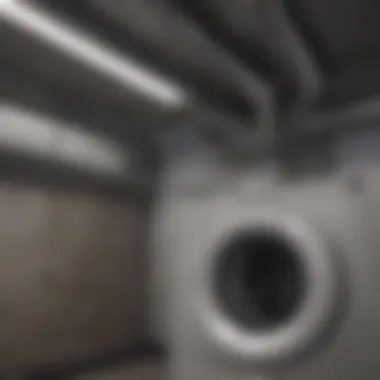Ultimate Guide to Cleaning Flexible Dryer Ducts Safely


Intro
Cleaning flexible dryer ducts may not seem pressing at first glance, but it carries substantial implications for safety and appliance efficacy. Over time, lint and debris can accumulate in these ducts, leading to clogs. This can result in inefficient drying cycles and increased risks of fire hazards. Understanding this, it becomes essential for homeowners to regularly maintain their dryer ducts.
In this guide, we provide not only the necessary steps and tools needed for cleaning but also insights into why these actions are critical. Whether you are a new homeowner or someone with experience, our focus on efficiency and safety throughout the cleaning process will benefit everyone.
With proper care, homeowners can enjoy prolonged dryer lifespans, improved performance, and reduced utility costs.
Regular cleaning transforms a mundane chore into a proactive strategy for a safer home and a fully functioning appliance. The pathway to effective cleaning is outlined below, with simplicity in mind to ensure a clear understanding.
Importance of Cleaning Flexible Dyer Ducts
- Safety: The leading reason behind regular cleaning is the reduced risk of fires. According to the U.S. Fire Administration, over 15,000 fires occur annually due to poorly maintained dryer ducts.
- Efficiency: Clean ducts allow air to flow freely. This reduces drying times and energy consumption, contributing to lower utility bills.
- Longevity of Appliance: A maintained duct system can enhance the life of the dryer. Parts do not wear out prematurely due to excessive force.
The subsequent sections explore tools needed, methods to employ, and common issues one might face during the cleaning process.
Prelude to Flexible Dryer Ducts
In households, flexible dryer ducts play a key role in the functionality and safety of clothes dryers. These ducts are designed to transport moist air away from the machine, preventing humidity buildup and ensuring efficient drying cycles. Understanding flexible dryer ducts is crucial for homeowners who wish to maintain optimal appliance performance and avoid potential hazards that arise from neglecting this aspect of home maintenance.
Definition and Purpose
Flexible dryer ducts, as the name suggests, are ducting systems made from various materials that allow for easy installation and maneuverability. They are designed to connect the dryer to the external vent, guiding hot, moist air outside. The primary purpose of these ducts is to facilitate the safe and effective removal of lint and moisture generated during drying cycles. If these ducts are not functioning optimally, it can lead to increased energy costs, lengthy drying times, and risks of fire hazards. Therefore, it is essential for homeowners to recognize the importance of keeping their dryer ducts clean and well-maintained.
Common Materials Used
Flexible dryer ducts are commonly made from several materials, each with its own advantages and drawbacks. The most common types include:
- Vinyl: This is lightweight and inexpensive but can be less durable and more prone to cracking over time.
- Aluminum: Known for its sturdiness and resistance to high temperatures, aluminum ducts help prevent lint buildup and reduce fire risks.
- Semi-rigid metal: This material strikes a balance between flexibility and rigidity. It is easier to maneuver than traditional rigid ducts while providing enhanced durability.
- Rigid metal: While not flexible, these ducts are the safest choice and are resistant to lint build-up.
Homeowners should choose ducts based on factors like installation ease, fire resistance, and overall durability. It’s worth noting that the material used can significantly affect long-term performance and safety.
These elements combine to establish a fundamental understanding of flexible dryer ducts within this comprehensive guide, emphasizing the need for regular maintenance and potential challenges associated with improper cleaning.
Significance of Cleaning Dryer Ducts
Cleaning dryer ducts is essential for multiple reasons, centered around safety, efficiency, and overall maintenance of your home appliance. Understanding the significance of maintaining clean ducts is crucial for homeowners. Not only does it help in prolonging the life of the dryer, but it also addresses risks that arise with neglect.
Prevention of Fire Hazards
One of the primary concerns with clogged dryer ducts is the potential fire hazard they introduce. Lint, which is a byproduct of drying clothes, accumulates over time in these ducts. This buildup restricts airflow and generates heat. If left unattended, the heat can ignite the lint, leading to significant fires. According to the U.S. Fire Administration, dryer fires cause an estimated 2,900 home fires annually, with failure to clean ducts being a major contributing factor.
Consider implementing the following measures to mitigate fire risks:
- Regular Inspection: Schedule inspections at least once a year. This can identify potential issues before they escalate.
- Lint Trap Maintenance: Clean the lint trap after every load to reduce the amount of lint entering the ducts.
- Professional Cleaning: Hiring professionals to clean the ducts can ensure thorough removal of lint and debris.
By prioritizing the cleaning of dryer ducts, homeowners can significantly reduce the likelihood of combustion events, protecting their property and ensuring family safety.
Improving Appliance Efficiency
Another significant benefit of maintaining clean dryer ducts is the improvement in appliance efficiency. When ducts are clogged, dryers work harder to push air through, resulting in longer drying times. Increased work translates to higher energy consumption and potentially premature wear on the machine.


Here are potential benefits to consider:
- Shorter Drying Times: A clear duct allows for optimal airflow, meaning laundry dries more quickly and efficiently.
- Energy Savings: With improved efficiency, homeowners see a decrease in energy bills as the dryer does not need to run as long to achieve its purpose.
- Extended Equipment Life: Keeping ducts clean encompasses the enhancement of dryer longevity, ultimately saving on repairs or replacements.
Remember: A clean dryer duct is a crucial component of both home safety and appliance performance.
When to Clean Flexible Dryer Ducts
Cleaning your dryer ducts is not just a good idea; it’s an essential part of maintaining your appliance's efficiency and safety. Understanding when to tackle this task can make a significant difference in your home. Regularly assessing the condition of your ducts can help in preventing serious issues.
Indicators of Clogging
There are several telltale signs that indicate it’s time to clean your flexible dryer ducts. Ignoring these signs can lead to fire hazards or reduced dryer performance. Here are some critical indicators:
- Drying Time: If you notice that your clothes are taking longer to dry than usual, this could mean that the airflow is restricted. This restriction often indicates that lint has begun to buildup in the ducts.
- Lint Accumulation: Visible lint buildup around the dryer vent or even inside the dryer itself is a clear sign of needing clean ducts. If you find lint buildup, it’s time to take action.
- Hot Dryer: If you find that your dryer is unusually hot to the touch when operating, airflow might be blocked. This overheating can lead to further damage.
- Burning Smell: A particular red flag is when you start to smell burning, which can signify lint catching fire. Do not ignore this!
"Regular cleaning of dryer ducts not only enhances appliance efficiency but also significantly lowers fire risks."
Observing any of these indicators should prompt immediate action to clean your ducts.
Recommended Frequency
How often should you clean your dryer ducts? This can vary based on several factors, including how often you use your dryer and the model of your appliance. Generally, it is recommended to clean your ducts at least once a year. However, here are some more specific guidelines:
- Families with Children: If you have a family, you might want to clean the ducts every six months, as frequent laundry can lead to faster lint accumulation.
- Pets: Homes with pets can require more frequent cleaning. Pet hair adds to lint and can block airflow sooner, so consider cleaning every six months.
- Light Usage: If you use your dryer less frequently, once a year might suffice. However, always pay attention to the indicators mentioned above.
- Older Machines: Older dryer models might require more frequent cleaning due to less efficient design. Consider checking the ducts every six to eight months.
Essential Tools for Cleaning
Understanding the right tools to use for cleaning flexible dryer ducts is essential for optimal maintenance. Selecting appropriate equipment not only enhances the effectiveness of the cleaning process but also minimizes the risk of damaging the ductwork. In this section, we will examine the basic cleaning tools required and explore optional equipment for deeper cleaning. Having the correct tools can significantly reduce the time and effort expended on this task, while ensuring a comprehensive cleaning is achieved.
Basic Cleaning Tools
When embarking on the journey to clean flexible dryer ducts, certain basic tools are non-negotiable. These tools serve as the foundation for an effective cleaning regimen.
- Vacuum Cleaner with a Hose Attachment: This versatile tool is essential for sucking out lint and debris from the ducts. A vacuum equipped with a long hose can reach into places that are otherwise inaccessible.
- Brush with Flexible Handle: A specialized duct cleaning brush is designed to reach the curved portions of the ductwork. The flexibility of the handle helps maneuver through tight spaces while effectively removing clogs.
- Lint Trap Cleaning Kit: These kits often come with attachments that fit into standard vacuum hoses, making it easier to clear lint from the trap and ducts simultaneously. They come in handy during routine maintenance as well.
- Screwdriver for Duct Disassembly: Depending on your dryer setup, you may need to disassemble certain sections of the duct. A screwdriver will allow you to do this safely.
Utilizing these basic tools will streamline your cleaning process and help maintain the integrity of your flexible dryer ducts.
Optional Equipment for Deep Cleaning
For those seeking a more thorough cleaning, optional equipment can provide added depth and efficiency. Although not required for basic upkeep, these tools may make a considerable difference in removing stubborn buildup and ensuring the ducts are in optimal condition.
- Rotary Dryer Vent Cleaning Brush: More advanced than standard brushes, these brush systems can attach to a drill. They spin at high speeds, effectively loosening debris that may have entrenched itself in the duct walls.
- Compressed Air Blower: This equipment can blast air through the ductwork, dislodging lint that a vacuum may not reach. It works exceptionally well for inaccessible areas.
- Inspection Camera: An inspection camera can be used to assess the interior of your duct system. This permits you to visualize the amount of buildup present and target your cleaning efforts effectively.
- High-Powered Vacuum: For those who regularly clean their ducts, investing in a high-powered vacuum designed for duct cleaning may be worthwhile. This equipment can handle larger volumes of lint and debris.
Investing in these optional tools can elevate your cleaning routine. They empower homeowners to feel confident about the condition of their dryer ducts.
Utilizing the right tools can enhance safety and efficiency during the cleaning process.
By arming oneself with both basic and optional cleaning tools, a homeowner is well-prepared to tackle the task of cleaning flexible dryer ducts with confidence.
Step-by-Step Cleaning Process


Cleaning your flexible dryer ducts involves a systematic approach to ensure effectiveness and safety. This step-by-step cleaning process is vital, as it not only removes lint buildup but also enhances the overall efficiency of your appliance. Understanding each step can help prevent common issues related to clogged ducts, such as fire hazards and inefficient drying.
Preparation of the Area
Before diving into the physical process, prepare the area around your dryer. Start by unplugging the appliance to ensure safety. Move any furniture or items obstructing the workspace. Having a clean and well-lit environment allows for better visibility and easier handling.
Next, gather all necessary tools by referring to the essential cleaning tools identified earlier. This preparation maximizes efficiency during the cleaning process, as you won't waste time searching for equipment. Also, make sure to wear safety gloves and goggles to protect yourself from dust and debris.
Disassembly of the Duct
The disassembly of the duct is a critical step in the cleaning process. Start by detaching the duct from the dryer. You may need to unscrew clamps or loosen connections, depending on the type of setup you have. Keep track of all screws and fasteners; a small container can be helpful to hold these items securely.
Once detached, check for any visible damage to the duct. If there are tears or significant wear, consider replacing the duct to maintain efficiency and safety. It is also essential to examine the vent on the exterior of your home for any blockages or damage before proceeding.
Cleaning Techniques
Effective cleaning techniques are necessary to remove lint and debris buildup. Here are the methods to consider:
Dryer Vacuum
Using a specialized dryer vacuum is one of the most effective approaches. These vacuums often come with attachments designed to reach into the duct. The key characteristic of a dryer vacuum is its powerful suction, which can easily pull out stubborn lint.
A dryer vacuum can be beneficial for its versatility; many models allow you to adjust suction power based on the task at hand. Its unique feature lies in the ability to remove both thick and compact lint, making it suitable for most cleaning scenarios. However, it may be less effective against sticky debris, which could require an alternative method.
Brush Method
The brush method is another practical cleaning technique. This method involves using a flexible brush, often with a long handle, to scrub the interior of the duct. One of its major benefits is that it physically dislodges lint that a vacuum might leave behind.
Some may find the brush method more tedious than other options. Yet, its effectiveness in capturing loose lint makes it a popular choice among homeowners. A unique feature of this method is its ability to adapt to various duct shapes and sizes, ensuring comprehensive cleaning.
Compressed Air
Lastly, using compressed air can be useful for cleaning hard-to-reach areas. This method involves directing a strong burst of air into the duct to blow out debris and lint. Its key characteristic is the speed at which it performs the cleaning.
Compressed air is beneficial for its convenience; it can quickly clear out loose material without needing extensive setup. However, human caution is required, as it may only partially remove stubborn clogs. A unique feature of this method is that it can be used in combination with other techniques for optimal results.
Reassembly and Testing
Once cleaning is complete, the next step is reassembling the duct. Attach the duct back to the dryer securely, ensuring all clamps are tightened appropriately. A proper fit is crucial to avoiding leaks and ensuring airflow efficiency.
After reassembly, reconnect the dryer to the power source and perform a test run. This testing phase allows you to verify that the appliance works correctly and that airflow is unobstructed. Monitor the operation closely for unusual noises or signs of inefficiency. If everything runs smoothly, you can consider the cleaning process successful.
Common Challenges and Solutions
Cleaning flexible dryer ducts is crucial for maintaining your appliance’s efficiency and ensuring safety in your home. However, various challenges can arise during this maintenance process. Understanding these challenges helps in preparing and implementing effective solutions.
Dealing with Stubborn Lint Buildup
Stubborn lint buildup is a frequent issue faced by homeowners. Over time, lint accumulates in the ducts, creating blockages that reduce airflow. This can lead to overheating and increase fire risks. Furthermore, a clogged duct decreases your dryer's efficiency, requiring longer drying cycles.
To address stubborn lint buildup, consider the following strategies:


- Vacuuming Regularly: Utilize a high-capacity vacuum designed for lint removal. This helps in reaching those tricky spots within the ducts.
- Using a Brush: A flexible lint brush can be very effective. Insert it through the duct's openings and move it back and forth to dislodge lint.
- Prolonged Cleaning Sessions: If the buildup is severe, multiple cleaning sessions may be necessary. Don’t rush the process, but rather take your time to ensure thorough cleaning.
By actively managing lint buildup, you can maintain the efficiency of your dryer.
Addressing Duct Damage
Duct damage is another challenge that homeowners may face. Over time, wear and tear, along with improper installation, can lead to cracks or punctures in flexible ducts. Damaged ducts can severely impact airflow and safety.
To effectively address duct damage:
- Regular Inspections: Frequent examinations of the ductwork can help to identify any issues before they become problematic. Look for visible signs of wear.
- Sealing Cracks: Use duct tape or a specialized sealant to secure any minor cracks. Ensure the area is clean for better adhesion.
- Replacing Sections: If the damage is extensive, replacement of specific duct sections may be required. Choosing to install high-quality ducts can prevent future issues.
Maintaining the integrity of your ducts is essential for optimal dryer performance and safety. By recognizing and responding to these common challenges, homeowners can ensure that their dryer functions effectively and safely.
Maintaining Clean Dryer Ducts
The practice of maintaining clean dryer ducts is crucial for optimal dryer performance, safety, and energy efficiency. Over time, lint, dust, and other debris accumulate in dryer ducts, leading to several potential issues. Regular maintenance not only prolongs the life of the appliance but also safeguards against the serious dangers associated with clogged ducts, such as fire hazards.
Adhering to a routine maintenance schedule ensures that lint buildup is managed effectively. A clean dryer duct allows for better airflow, which contributes to efficient drying cycles. This can reduce energy consumption, save on utility bills, and decrease wear on the dryer itself. Consequently, the investment in regular maintenance often pays for itself in energy savings and extended appliance life.
Additionally, neglecting dryer duct maintenance can lead to severe outcome like reduced airflow and ultimately even dryer malfunction. Homeowners should be vigilant and proactive about dryer duct care. Simple steps can lead to significant benefits all round.
"Preventive maintenance plays a vital role in appliance longevity and safety."
Routine Maintenance Tips
To maintain clean dryer ducts effectively, several practical tips can be followed. These steps help minimize lint accumulation and promote efficient dryer operation:
- Inspect the Duct Regularly: Make it a habit to check the duct every few months. Look for visible lint and debris. If you notice any buildup, it is time to clean.
- Clean the Lint Trap: After each use, clean the lint trap thoroughly. This is your first line of defense against lint buildup.
- Use a Dryer Vent Brush: Invest in a vent brush and use it occasionally to reach deeper areas of the duct. This will help dislodge any lint that has settled in tight spots.
- Check Duct Connections: Ensure that all joints and connections are secured and sealed. Loose connections can trap lint.
- Ensure Proper Venting: Make sure the dryer is vented outdoors and that the duct is free of kinks or bends. This facilitates smooth airflow.
These routines, while simple, can make a notable difference in the performance of your dryer and the safety of your home.
Professional Cleaning Services
While routine maintenance is essential, there are times when professional assistance is recommended. Hiring a cleaning service can be particularly beneficial in the following scenarios:
- Heavy Build-Up: If you notice extensive lint accumulation that you cannot remove effectively, a professional service can perform a thorough cleaning.
- Long Duct Runs: In homes where ducts are extensive or complex, expert equipment and experience are necessary. Professionals have specialized tools to navigate and clean long stretches of ductwork.
- Frequent Dryer Issues: If your dryer frequently overheats or takes multiple cycles to dry clothes, it might indicate a problem in the duct system that professionals can diagnose accurately.
- Time Constraints: For homeowners with busy schedules, hiring professionals can save time and ensure the job is done right.
Engaging professional cleaning services not only provides clean ducts but also peace of mind. It assures that the appliance functions safely and efficiently, reducing the risk of lint-induced fires and ensuring a more reliable drying experience.
Ending
In the realm of household maintenance, the topic of cleaning flexible dryer ducts emerges as a vital concern for homeowners. It goes beyond mere cleanliness; it directly relates to the safety and efficiency of a potentially hazardous appliance. In this article, we have thoroughly examined the significance of regular cleaning, practical methods for achieving it, and the tools needed for effective duct maintenance.
Regularly cleaning dryer ducts not only reduces the risk of fire but also enhances appliance efficiency, thus saving energy and prolonging the lifespan of the dryer. As we delve into this exploration, it becomes clear that a proactive approach leads to substantial benefits.
Recap of Best Practices
To maintain dryer ducts effectively, several best practices should be kept in mind:
- Inspect Regularly: Conduct inspections every few months to identify any signs of lint buildup or potential blockages.
- Use Appropriate Tools: Equip yourself with high-quality tools like dryer vacuums and brushes to ensure thorough cleaning.
- Address Issues Promptly: Don’t delay in dealing with any observed clogs or duct damage, as this can escalate into larger problems.
- Consider Professional Services: Engage professional cleaning services periodically for a deep clean. They have specialized equipment and expertise to ensure complete removal of lint and debris.
Final Thoughts on Dryer Duct Maintenance
Maintaining clean dryer ducts is not just about routine cleaning. It encompasses understanding the risks associated with clogged ducts and acknowledging the signs that indicate a need for immediate action. While many homeowners may overlook the importance of this maintenance task, the potential consequences of neglect can be severe.
In summary, it is essential for every homeowner to prioritize dryer duct maintenance. Small efforts can have a significant impact on safety and efficiency. Stay informed, take action, and ensure your appliance operates at its best. Your diligence today can prevent hazards tomorrow.















